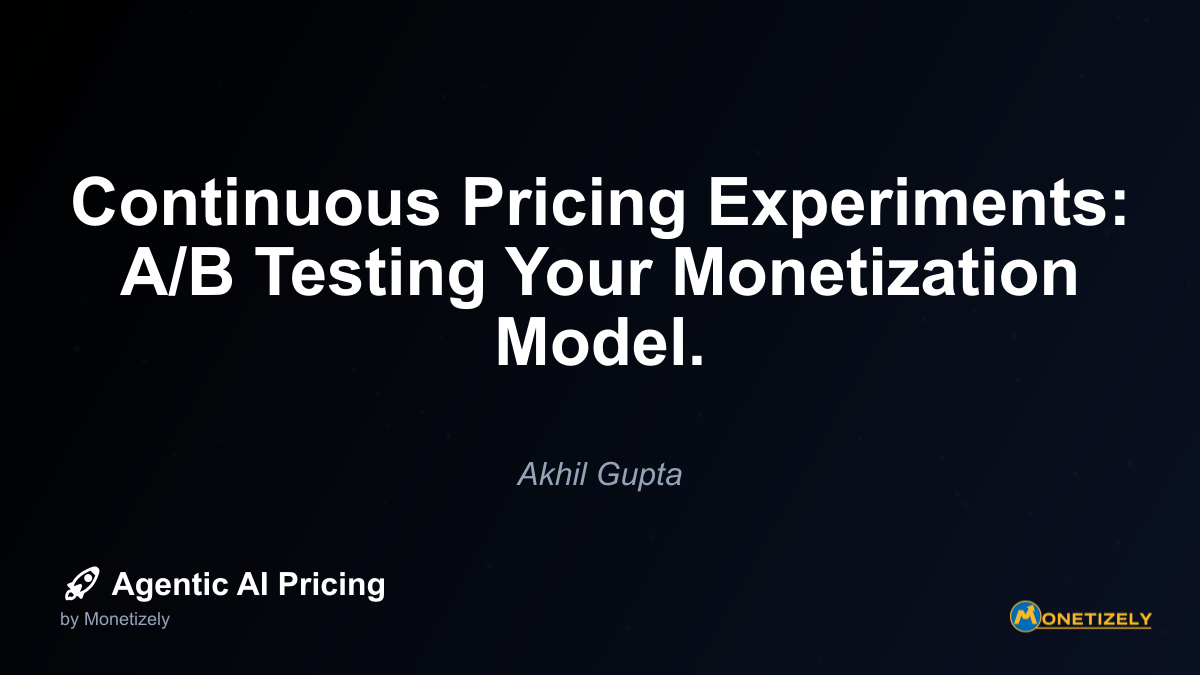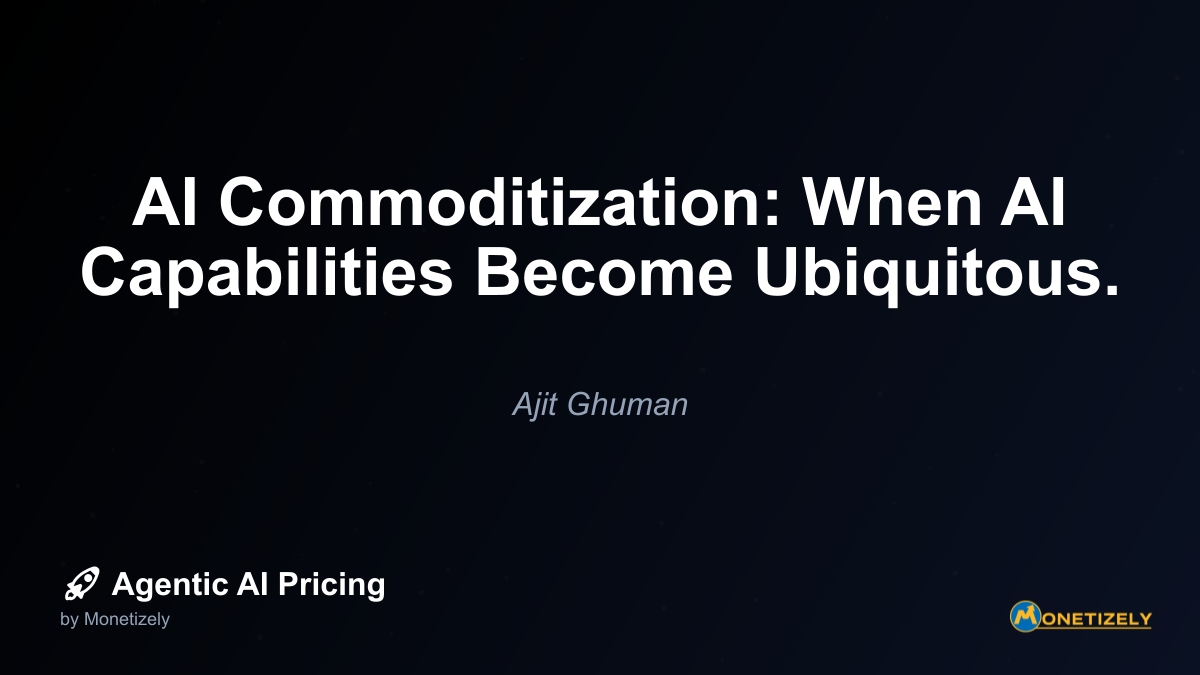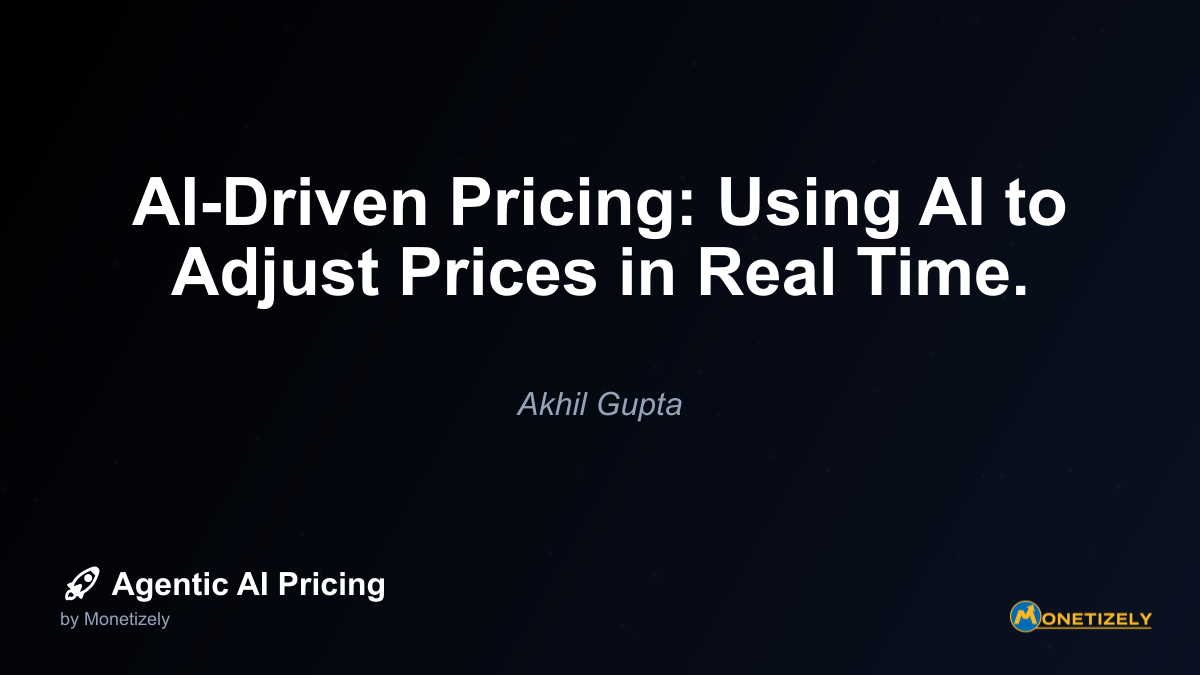· Akhil Gupta · Emerging Trends · 6 min read
Continuous Pricing Experiments: A/B Testing Your Monetization Model.
AI and SaaS Pricing Masterclass
Learn the art of strategic pricing directly from industry experts. Our comprehensive course provides frameworks and methodologies for optimizing your pricing strategy in the evolving AI landscape. Earn a professional certification that can be imported directly to your LinkedIn profile.

Real-World Examples of Successful Pricing Experiments
Case Study 1: Enterprise SaaS Platform
A leading enterprise SaaS platform discovered through A/B testing that their initial three-tier pricing model was causing decision paralysis. By experimenting with a simplified two-tier model alongside a custom enterprise option, they observed:
- 24% increase in trial-to-paid conversion rates
- 18% higher average contract value
- Reduced sales cycle length by 9 days on average
The company gradually rolled out the new pricing structure to all markets after validating results across multiple customer segments.
Case Study 2: AI-Powered Analytics Tool
An analytics company using agentic AI tested different value metrics for their product:
Test Group A: Fixed monthly fee plus per-seat pricing Test Group B: Base fee plus usage-based pricing tied to data processed Test Group C: Outcome-based pricing tied to cost savings identified
The results showed that while Group B generated the highest initial conversion rates, Group C produced the highest customer lifetime value and lowest churn. This insight led them to adopt a hybrid model that incorporated elements of both approaches.
Case Study 3: Collaboration Software
A collaboration platform conducted sequential pricing experiments over six months:
- First, they tested a 15% price increase across all tiers (result: 8% revenue increase despite 4% lower conversion)
- Next, they tested adding premium features to justify the higher price (result: conversion rates recovered while maintaining higher prices)
- Finally, they tested different annual discount structures (result: 25% discount drove significantly more annual commitments than 20%)
This sequential approach allowed them to optimize multiple pricing dimensions while carefully measuring the impact of each change.
Challenges and Pitfalls in Pricing Experimentation
While pricing experimentation offers tremendous potential, it also presents significant challenges:
1. Customer Perception Risks
Customers may react negatively if they discover they’re being charged different prices than others. Mitigate this by:
- Testing with new customers only when possible
- Being transparent about “beta pricing” programs
- Ensuring sales and support teams can explain the rationale
- Having clear policies for addressing customer concerns
2. Technical Complexity
Supporting multiple pricing structures simultaneously creates technical challenges:
- Billing systems may struggle with different price points and metrics
- CRMs need to track which customers are in which experiments
- Financial forecasting becomes more complex
- Contract management systems need flexibility
Invest in systems that can handle this complexity or limit the scope of experiments to what your infrastructure can support.
3. Statistical Challenges
Many pricing experiments fail to yield actionable insights due to statistical issues:
- Insufficient sample sizes leading to inconclusive results
- Confounding variables that weren’t properly controlled
- Too many simultaneous changes making causation difficult to determine
- Seasonal effects distorting outcomes
Work with data scientists or statisticians to design experiments that will produce reliable results.
4. Organizational Alignment
Pricing changes impact multiple departments, requiring careful alignment:
- Sales teams need to understand and communicate test pricing
- Finance needs to account for revenue variances during experiments
- Product teams must support different feature sets across test groups
- Legal must ensure compliance with terms of service
Create cross-functional teams to oversee pricing experiments and ensure all perspectives are considered.
The Future of Pricing Experimentation
As agentic AI continues to transform business operations, pricing experimentation is evolving in several important directions:
1. Personalized Pricing at Scale
The future of pricing experimentation lies in increasingly granular segmentation, potentially leading to personalized pricing based on:
- Individual usage patterns
- Demonstrated value received
- Willingness to pay signals
- Industry-specific value metrics
- Geographic and economic factors
Machine learning algorithms will increasingly analyze these factors to suggest optimal pricing for each customer segment or even individual accounts.
2. Automated Experimentation
AI-powered systems will continuously run pricing micro-experiments, automatically:
- Identifying promising test opportunities
- Designing statistically valid experiments
- Allocating customers to appropriate test groups
- Analyzing results and implementing winning variations
- Learning from historical experiment data
This will accelerate the pace of pricing optimization beyond what manual processes can achieve.
3. Dynamic Value-Based Pricing
The most advanced pricing systems will shift toward real-time, dynamic pricing based on:
- Actual value delivered to each customer
- Current system capacity and costs
- Competitive positioning
- Customer expansion potential
- Risk factors and implementation costs
This approach represents the ultimate evolution of pricing experimentation—continuous adjustment based on real-time value metrics.
How to Get Started with Pricing Experiments
For companies new to pricing experimentation, here’s a pragmatic approach to getting started:
1. Begin with Low-Risk Experiments
Start with experiments that minimize potential downside:
- Test with new customers rather than existing ones
- Experiment in smaller markets before core territories
- Test modest price variations before radical changes
- Focus on add-on features before core offerings
This approach builds organizational confidence and capabilities while limiting risk.
2. Create a Pricing Experiment Roadmap
Develop a sequential plan for pricing experiments:
- Identify 3-5 key hypotheses to test over the next year
- Prioritize based on potential impact and implementation complexity
- Schedule experiments to avoid conflicting with major product releases or business cycles
- Plan for adequate sample collection periods
This roadmap creates a structured approach to building pricing knowledge.
3. Invest in Measurement Infrastructure
Before launching significant experiments, ensure you can measure what matters:
- Implement funnel tracking across all test variations
- Create dashboards for monitoring key metrics
- Establish processes for collecting qualitative feedback
- Set up regular experiment review meetings
Without proper measurement, experiments yield limited insights.
4. Build Cross-Functional Ownership
Create a pricing committee with representatives from:
- Product management
- Sales
- Marketing
- Finance
- Data science
- Customer success
This group should oversee experiment design, implementation, and analysis while ensuring organizational alignment.
5. Document and Share Learnings
Create a knowledge repository for pricing experiments:
- Document all hypotheses tested, regardless of outcome
- Record detailed methodologies for future reference
- Share insights across the organization
- Use learnings to inform future experiment design
This institutional knowledge becomes increasingly valuable over time.
Integrating Continuous Pricing Experiments into Your Overall Strategy
For pricing experimentation to deliver maximum value, it must be integrated into your broader business strategy:
Align with product development: Coordinate pricing experiments with your product roadmap to test monetization of new features.
Connect with customer research: Use insights from customer interviews and surveys to inform pricing experiment hypotheses.
Inform financial planning: Factor expected learnings from pricing experiments into revenue forecasts and growth projections.
Support go-to-market strategies: Design experiments that test pricing for different acquisition channels and customer segments.
Enhance competitive positioning: Use experiments to find the optimal price-value relationship relative to competitors.
When properly integrated, pricing experimentation becomes a strategic advantage rather than an isolated tactical exercise.
Conclusion: Embracing the Experimental Mindset
The shift from static pricing to continuous pricing experimentation represents a fundamental change in how companies approach monetization. By treating pricing as an ongoing series of hypotheses to be tested rather than fixed decisions, organizations can:
- Discover optimal price points that maximize revenue
- Identify the most effective value metrics for their offerings
- Understand willingness to pay across different segments
- Adapt quickly to changing market conditions
- Build pricing as a competitive advantage
For agentic AI companies in particular, where value propositions are still evolving and customer expectations are being established, this experimental approach is essential for capturing maximum value while driving adoption.
The most successful companies will be those that build robust capabilities for continuous pricing experimentation—treating each pricing decision not as a final answer but as the starting point for the next round of discovery and optimization.
By implementing the strategies outlined in this article and committing to data-driven decision making, you can transform pricing from a periodic task into a continuous source of competitive advantage and revenue growth. The era of set-it-and-forget-it pricing is over; the age of continuous pricing experimentation has arrived.
For more insights on effective testing strategies, check out our comprehensive guide on advanced pricing experimentation methods that goes deeper into sophisticated testing approaches. If you’re just getting started, our detailed walkthrough on designing your first SaaS pricing A/B test provides step-by-step guidance for implementing a data-driven approach.
Co-Founder & COO
Akhil is an Engineering leader with over 16+ years of experience in building, managing and scaling web-scale, high throughput enterprise applications and teams. He has worked with and led technology teams at FabAlley, BuildSupply and Healthians. He is a graduate from Delhi College of Engineering and UC Berkeley certified CTO.
Pricing Strategy Audit
Let our experts analyze your current pricing strategy and identify opportunities for improvement. Our data-driven assessment will help you unlock untapped revenue potential and optimize your AI pricing approach.




